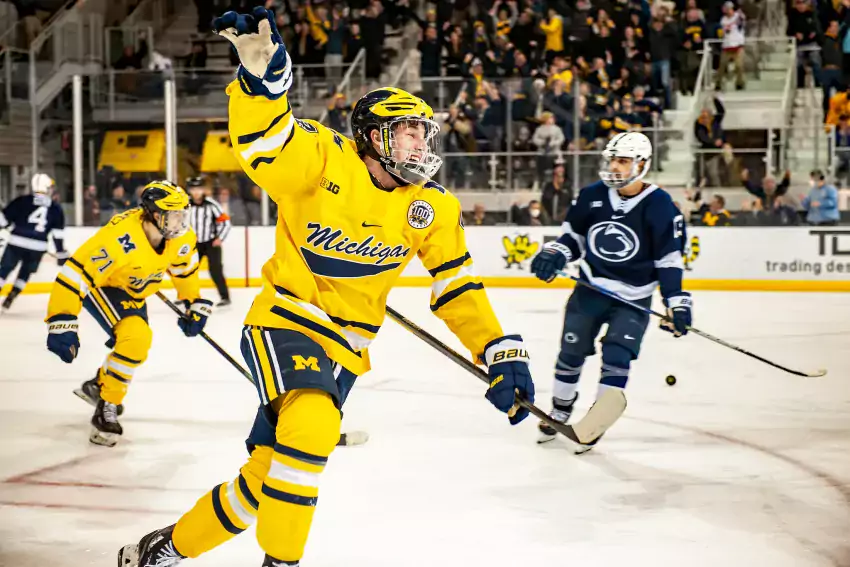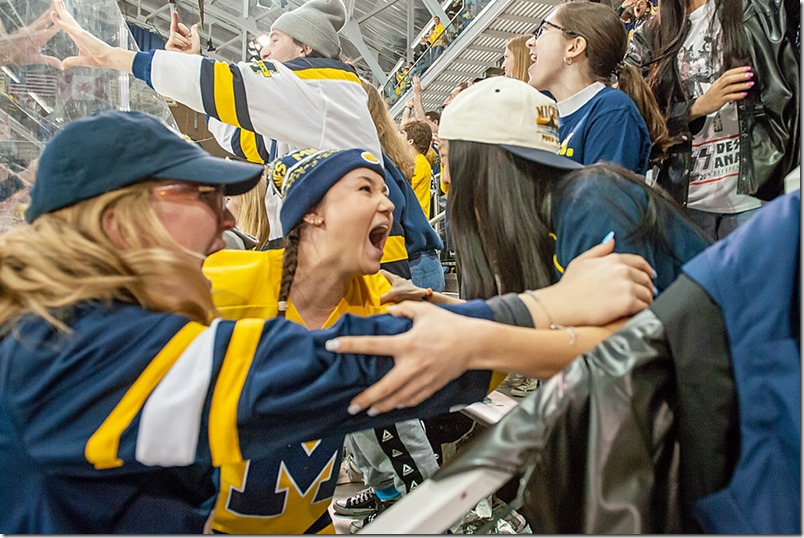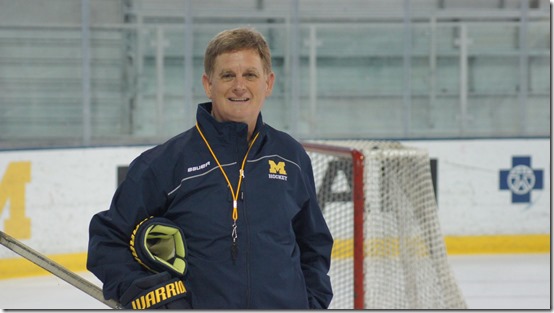yost ice arena

1/27/2023 – Michigan 7, Penn State 3 – 16-9-1, 5-6 Big Ten
1/28/2023 – Michigan 5, Penn State 4 – 16-9-1, 6-6 Big Ten
Once, during my long tenure in the student section, I had a mad, fleeting thought. I was pretty sure I was standing next to Cam Fowler, then a 17-year-old kid committed to Notre Dame, later a top-15 NHL draft pick and long-term NHL defenseman. Fowler would never make it to South Bend, instead defecting to the OHL, but at the time he was rooting for his team, with his phone out, chortling in a way that drove me insane.
Michigan had a goal disallowed. Later in the game a Notre Dame player scored on the clearest kicking motion I have ever seen; the replay review was inconclusive, apparently because the kick had come from far enough out that the overhead camera did not catch it. Yost roared in outrage, and Fowler chortled and typed out something on his phone. The urge to grab Fowler's phone and hurl it onto the ice rose up unbidden inside of me. The higher portions of the mind immediately dismissed such a course of action, but the combination of Yost Ice Arena and a clear injustice had the rink poised on the precipice of madness.
This was a fairly common occurrence throughout the 90s.
Things changed. Dave Brandon's renovations took out more seats and mate them shiny metal instead of Yost's old black menace. The students were almost entirely removed from the glass. The section shrunk. Smartphones came in; fewer students were antisocial weirdos; piped-in music frequently drowned out episodes when the shadow of old Yost threatened to come back in. Yost is still a great venue for hockey, but it is not Old Yost. The malevolence is largely gone.
But, hey, if you take away a goal to make it 2-1 with a bullshit review that disallows a goal and gives Michigan a five-minute major penalty on an incident that occurred almost a minute before the actual goal, well, turns out the old dog can still get up and bark.
-------------------------------------------
Back in the day, Yost had a reputation. It still has a reputation, yes. But the reason we have this insane tournament system today is directly traceable to the years Yost hosted back-to-back regionals in which they beat one-seeds to reach the Frozen Four. This happens all the time, yes. But those two regionals felt like the building picking up the team and morphing the team into avenging gods, the kinds of gods with eyepatches and scars and deep interpersonal loathings that can only be settled at the end of the world.
This is not a rational thought. Home ice in hockey is not really a determining factor. But that feeling was so widespread that the powers that be in college hockey opted for antiseptic, empty neutral site regionals in the worst tournament in sports instead of give Yost another crack ever again. Madness of a different sort. At this distant remove it feels silly.
Do not tell the powers that be this, but two days after Michigan 5, Penn State 4 it does not feel silly. Here is what happened: Penn State scored two goals in the first 90 seconds and put up 20 shots in the first period. Michigan managed to scratch and claw back into the game, somewhat. With about 10 minutes left in the second period, they score a power-play goal. PSU asks for a review, Edwards gets called for a major for contact to the head as a PSU player suddenly spins around with his head at chest height, and they wipe a goal off the board despite the puck not only leaving the offensive zone but going all the way down to the opposite boards.
This may in fact be the way college hockey wants to officiate itself but what it is not is anything resembling justice. Michigan eats a goal on the five-minute power play, and then Adam Fantilli and Luke Hughes get very very angry, as angry as Yost appears to be.
For a period and a half they enact Ragnarok on a team with a 3-0 lead. Hughes torments Penn State defenders en route to four goals and—probably more impressively—11 shots. PSU, the kings of shooting from anywhere and everywhere, end up with fewer shots in the second and third periods than they had in the first. Despite being shorthanded, and getting more short handed in the third period when Seamus Casey leaves the ice, they run over Penn State. Dylan Duke gets a partial breakaway goal to tie it, and in the stands I am more or less content to take a win and a tie from the series.
[Bill Rapai]
Luke Hughes is not, and fires a top-shelf wrister to go up 5-4 with ten minutes left. All of this madness took under a period of hockey. By the time it's time for Penn State to pull their goalie, Michigan bottles up the Nittany Lions for a minute and a half; they only get an extra attacker on with 30 seconds left in the game.
[Rapai]
Sit, exhale, and oh yes. That's what it was like. That's what it used to be. Wings of fury. Get me a cigarette. I don't even smoke.
[After THE JUMP: broken officiating, pairwise, adversity checklist]

In 1946, Penn State was scheduled to play the University of Miami, which like most Southern teams of the time still refused to play integrated Northern teams unless they sat their Black players. At the time Penn State had two, and of them only Wally Triplett was a regular. By a team vote, PSU canceled the 1946 Miami game, an act that Triplett credits for the origins of its great 1947 campaign, when Penn State swept its regular season opponents and earned an invite to the Cotton Bowl.
The Cotton was one of four bowl games in existence, and one of three, the Rose excepted, with standing rules against Black players participating. Responding to rumors that administrators were talking to SMU about sitting Triplett, PSU captain Steve Suhey told the press “We play all or none, there will be no meetings.” Triplett played, and scored the game-tying touchdown. Though the school’s claim that this event and the “We Are…” cheer are connected is completely apocryphal, the moment is a special point of pride for the Nittany Lions.
Michigan could have had that moment a dozen years earlier, when Georgia Tech came to Ann Arbor in 1934, and over vocal opposition from campus protestors and the greater Michigan community, Fielding Yost agreed to sit star end Willis Ward. The details of this event have been covered many times, first as dug up by Dr. John Behee in his first book Hail to the Victors! Black Athletes at the University of Michigan (1974), then in the Black and Blue documentary based on his findings, and most recently and thoroughly by the President’s Advisory Committee Report on the Fielding H. Yost Name on the Yost Ice Arena Historical Analysis.
Yesterday this committee tasked with looking at whether Michigan should rename its buildings issued its unanimous recommendation to President Schlissel that Fielding Yost’s name should be removed from Yost Ice Arena. The report is 36 pages, and informs the committee’s six-page unanimous recommendation.
As someone who talks Yost history often, most recently in an interview on the history of the Big House that aired on student television, I hope to provide some context on the committee’s findings. I will refrain from adding my opinion on the building’s name until the end because next to the facts and the opinions of those more directly affected I don’t believe my feelings, colored as they are by my history of covering Yost, should carry much weight.
Committee, Report and Conclusions
The committee begins their recommendation letter with an unattributed message from a Michigan alum asking that the name be reconsidered because “In naming the Field House after Yost, the University chose to place one man's contributions to football and to athletics above the profoundly deep and negative impact he had on people of color,” and continued to do so over several opportunities to rename it.
The committee responds to this in the summary of its conclusion:
While we acknowledge that Yost had both successes and failures in his career, our historical analysis suggests to us that the benching of Ward was not an aberration but rather epitomized a long series of actions that worked against the integration of sports on campus.
The committee also lays out what it believes should be the standard for “honorific” naming of buildings, which is:
The names on our buildings constitute a “moral map” of our institution and should enshrine the values that we uphold.
By this standard they make a convincing case that Yost’s actions in the Willis Ward affair did not represent core values of the University of Michigan as they were formally stated in Yost’s time, or as they are instituted in practice today.
The committee was created in 2017 as the active arm of the university’s new review process for renaming buildings, and President Schlissel followed its first two recommendations, removing the names of noted eugenicist CC Little and crank scientist Alexander Winchell. In the future the same committee will likely be tasked with a recommendation on the honorific naming of Schembechler Hall, and the financial naming gift of the Weiser Center for Emerging Democracies.
[Hit THE JUMP]
[courtesy U-M Athletics]
It’s a cooler than usual Monday in September outside Yost Ice Arena, nature’s heavy-handed hint that hockey season is just weeks away. Inside, the new head coach’s office looks decidedly less new than it did a few weeks ago. The smell of leather fills the air—new chairs—albeit less so than in July. The built-in book cases have filled up with years of accolades and other snapshots from a life in hockey.
Framed photos line the upper shelves, but Mel Pearson doesn’t reach for those. Asked how he first got involved in hockey, he rises from his chair and plucks a photo from the top left corner of the furthest shelf to the left. It’s propped up in front of another picture, the lone unframed photo in the bunch. Pearson lays it down on his desk next to the neatly organized stacks of paper, presumably drills and practice plans and scouting reports that bear the emblems of teams from all over; one of the stacks is topped with a sheet that has the Pittsburgh Penguins’ logo in the top corner. “You’re just sort of born into it,” Pearson says, pointing to the back row of the photo. “This is Coach Berenson—this is an All-Star team up in Saskatchewan—and that’s my dad, so they actually had some history. It’s awesome. So they played together.”
It feels like a foundational event, a peek behind the curtain, the revelation of the moment that destiny staked its claim on a kid from Flin Flon, Manitoba. In reality, Pearson’s point is that the hockey world can be an awfully small place. George “Mel” Pearson’s son was about to criss-cross North America, a party to his father’s dream, soon to discover that sentiment was more true than he ever could have guessed.
[After THE JUMP: ties, timing, and the moment it all came together]



67